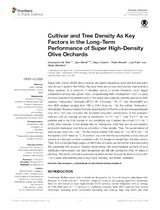Cultivar and Tree Density As Key Factors in the Long-Term Performance of Super High-Density Olive Orchards
Autor
Díez, Concepción M.
Moral, Juan
Cabello, Diego
Rallo Romero, Luis
Barranco Navero, Diego
Morello Parra, Pablo
Editor
FrontiersFecha
2016Materia
Olea europaea L.Orchard design
Oil yield
Biennial bearing
Hedgerows
METS:
Mostrar el registro METSPREMIS:
Mostrar el registro PREMISMetadatos
Mostrar el registro completo del ítemResumen
Super high-density (SHD) olive orchards are rapidly expanding since the first plantation
was set up in Spain in the 1990s. Because there are no long-term studies characterizing
these systems, it is unknown if densities above a certain threshold could trigger
competition among fully-grown trees, compromising their development. Over 14 years
we have evaluated the performance of the major olive cultivars currently planted in SHD
systems (“Arbequina,” Arbequina IRTA-i·18, “Arbosana,” “Fs-17,” and “Koroneiki”) and
nine SHD designs ranging from 780 to 2254 trees ha−1 for the cultivar “Arbequina.”
Remarkably, the accumulated fruit and oil production of the five cultivars increased linearly
over time. Our data indicated the favorable long-term performance of the evaluated
cultivars with an average annual oil production of 2.3 t ha−1. Only “Fs-17” did not
perform well to the SHD system in our conditions and it yielded about half (1.2 t ha−1)
of the other cultivars. In the density trial for “Arbequina,” both fruit and oil accumulated
production increased over time as a function of tree density. Thus, the accumulated oil
yield ranged from 16.1 t ha−1 for the lowest density (780 trees ha−1) to 29.9 t ha−1 for
the highest (2254 trees ha−1). In addition, we note that the accumulated production per
surface unit showed a better correlation with the hedgerow length than the tree density.
Thus, the current planting designs of SHD olive orchards can be further improved taking
this parameter into account. Despite observations that some irregular patterns of crop
distribution have arisen, our olive hedgerows are still fully productive after 14 years of
planting. This result contradicts previous experiences that showed declines in production
7 or 8 years after planting due to high vigor, shading, and limited ventilation.

